Home
A comprehensive resource for safe and responsible laser use
US: Los Angeles bans lasers from demonstrations
At an October 27 2020 public meeting, the deputy chief of the L.A. Police Department, said "… we have experienced numerous instances of individuals among these groups intentionally using laser devices and pointers to attempt to blind and cause harm to officers by pointing them purposely at their eyes…. Laser-type devices have no legitimate use outside of the business or educational venues."
The department warned officers to "adjust their vision" to avoid laser beams, and "has since sought to use eyewear and screens" to protect eyes from laser light.
An LAPD spokesperson said thus far in 2020, there had been 20 incidents of laser pointers being used to blind or distract people. Twenty-four people reported eye damage during the incidents, according to the spokesperson. Twenty of them were police officers; some were driving at the time.
The Los Angeles Times reported "In July, LAPD Officer Kyle Rice lost his vision in his right eye, as well as his ability to balance, and was left with migraine-like headaches after he was targeted with a laser pointer after responding to a radio call of a disturbance in Little Tokyo. A person not involved in the dispute between an homeless person and a business owner is accused of pointing the laser at Rice’s eye. An arrest was made in the incident."
According to the L.A. Sentinel, "Some people who spoke during the meeting said it was ironic that the LAPD was asking for a laser-pointer ban at protests, as officers have been photographed using bean bag projectiles that have allegedly caused gruesome injuries to some protesters, such as lost eyeballs and teeth."
Section 55.07 also prohibits items such as wood, pipe, hard signs, baseball bats, aerosol spray (tear gas, mace, pepper spray), firearms, BB guns, tasers, knives, glass bottles, open flame torches, shields of metal, wood or hard plastic, bricks, and rocks.
From the Los Angeles Times, and from the City News Service via the L.A. Sentinel and NBC Los Angeles. More on officer Kyle Rice is here.
China: "Laser AK-47" assault rifle said to be manufactured; experts skeptical
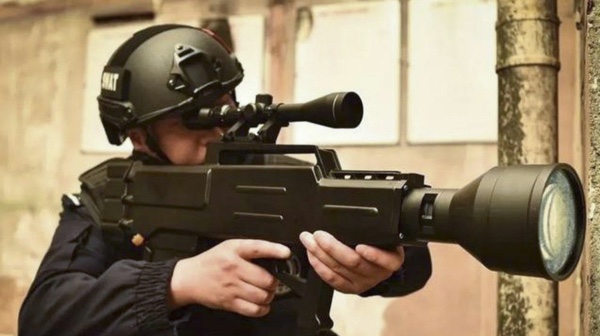
The July 1 2018 report appeared the In South China Morning Post. It quoted a “researcher who had [taken] part in the development and field testing of a prototype at the Xian Institute of Optics and Precision Mechanics at the Chinese Academy of Sciences in Shaanxi province. The source said “The pain will be beyond endurance.” Another researcher said that because the beam is invisible and noiseless, “nobody will know where the attack came from. It will look like an accident.”
A technical document stressed the “non-lethal” nature of the laser rifle, listing attacks such as burning the banners or clothing of “illegal protests”.
The laser capability claims were disputed, however, by numerous news outlets.
TechCrunch writer Devin Coldewey first noted that military laser systems capable of delivering damaging heat over hundreds of meters require “on the order of tens of kilowatts, and those have trouble causing serious damage.” He calculated that a Tesla Powerwall using lithium ion batteries produces a few kilowatts of power and weighs over 200 pounds. (The complete laser rifle weighs 6.6 pounds.) Coldewey said the problem was atmospheric attenuation of the laser beam which is “non-trivial at anything beyond, say, a few dozen meters. By the time you get out to 800 [meters, the laser’s claimed range] the air and water the beam has traveled through [are] enough to reduce it [to] a fraction of its original power.”
US: Toy helicopter powered by 500-watt laser beam; kept aloft for more than a day
They noted that the technique could be scaled up to create laser-powered drones that could do useful work: “commercial laser-powered flight applications are only a few years away.”
Click to read more...
UK: Handheld (industrial) laser easily cuts through metal
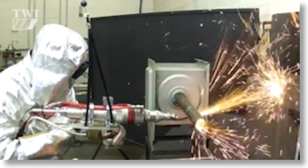
The device came to public attention September 28 2013 when gadget blog Gizmodo published an article entitled Holy Crap, This Real-Life Laser Rifle Cuts Through Metal Like Nothing. The article links to TWI’s YouTube video of the laser in action.
US: Military aircrews can use finger-mounted laser pointers for target identification
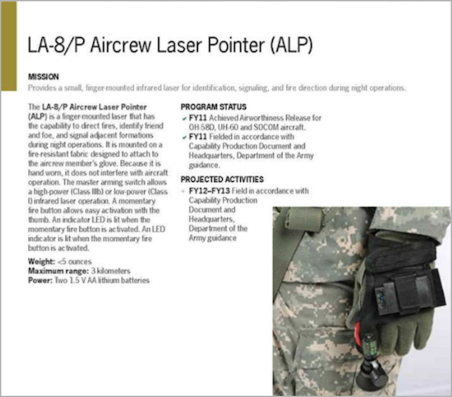
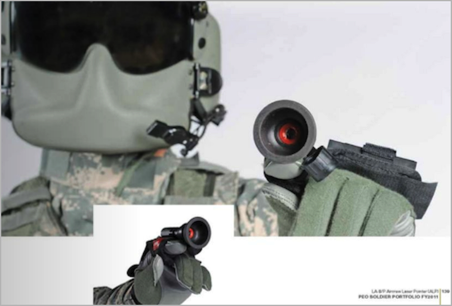
For the military laser enthusiast, the catalog contains a number of other laser devices such as the AN/PEQ-14 Integrated Laser White Light Pointer (actually a white flashlight plus a visible and an invisible laser):
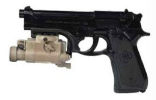
From the Program Executive Officer Soldier Portfolio FY2012 catalog. The LA-8/P is on printed pages 138-139, electronic pages 146-147. Originally found via GovWin.
Commentary from LaserPointerSafety.com: Although the LA-8/P Aircrew Laser Pointer does not emit a visible beam, it would be easy to make a visible version so that aircrews could “fire back” at persons on the ground aiming laser pointers at them. Whether this is a wise idea is another matter.
.
US: UPDATED - Danger of infrared light from some green laser pointers
The NIST team came up with a simple “home test” so that interested persons can test their own laser pointers. The test requires a digital or cellphone camera, a compact disc used to spread out the wavelengths, a webcam to view infrared light, and an infrared TV remote control.
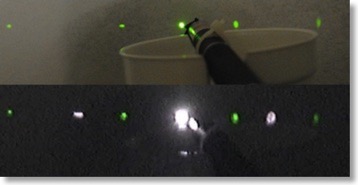
At top, light from a green laser pointer is diffracted (spread out) by a compact disc and viewed with a digital camera that can see only visible light. At bottom, a webcam with no infrared-blocking filter shows this laser also emits infrared laser light (white dots). For this unit, the invisible infrared light is more powerful than the visible green light. (NIST photo)
The unwanted and potentially hazardous infrared light is due to misaligned or missing filters in laser pointers that use infrared to generate visible green light. Low-cost pointers are at special risk, due to cutting corners in design, materials or manufacture to reduce costs.
The team warns that, whether or not a laser pointer emits dangerous levels of infrared, users should “never point the lasers at the eyes or aim them at surfaces such as windows which can reflect infrared light [as well as visible light] back to the user” or others in the area.
For more information:
- NIST press release summarizing the issue
- NIST technical note A Green Laser Pointer Hazard which includes instructions on how to test to see if a green laser pointer has unwanted or excess infrared light emission (PDF format)
UPDATE - March 2011: A laser expert has privately warned LaserPointerSafety.com that the CD technique requires caution. This is because when the laser light is diffracted, the infrared light is no longer co-linear (same path) as the visible light. Therefore, the viewer cannot know exactly where the IR light is going unless they are looking through an IR-sensitive camera or webcam.